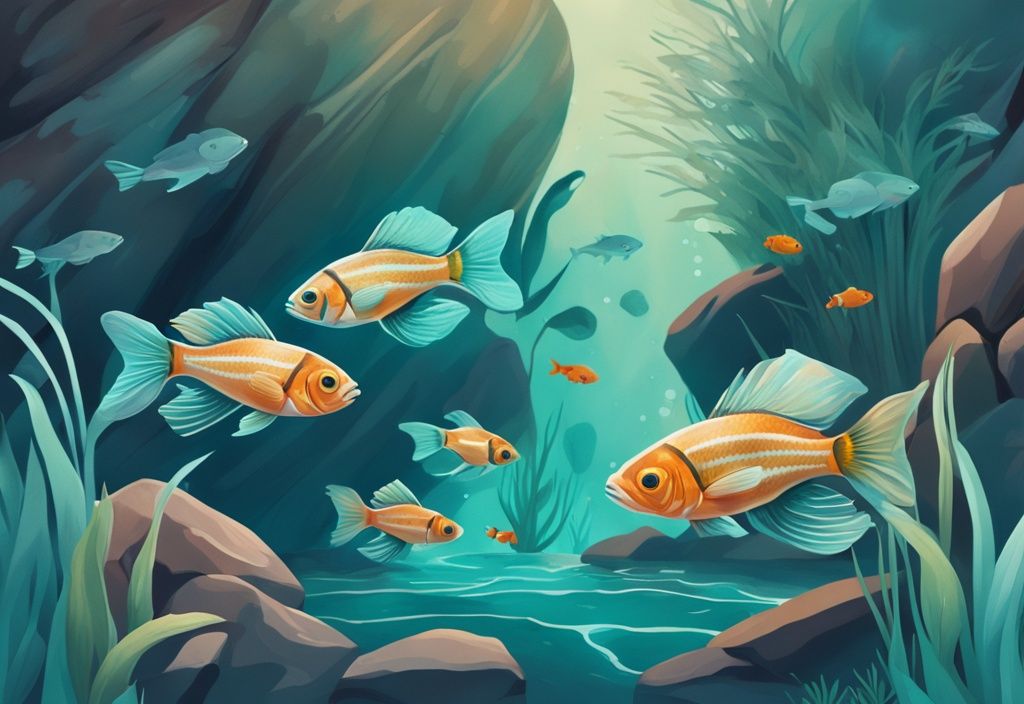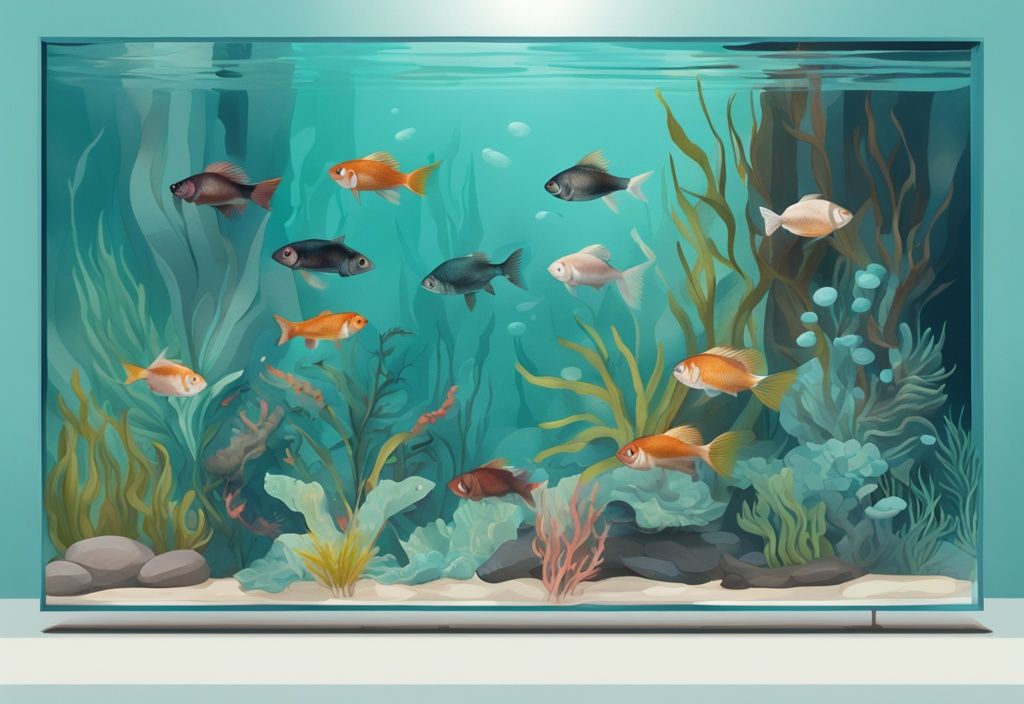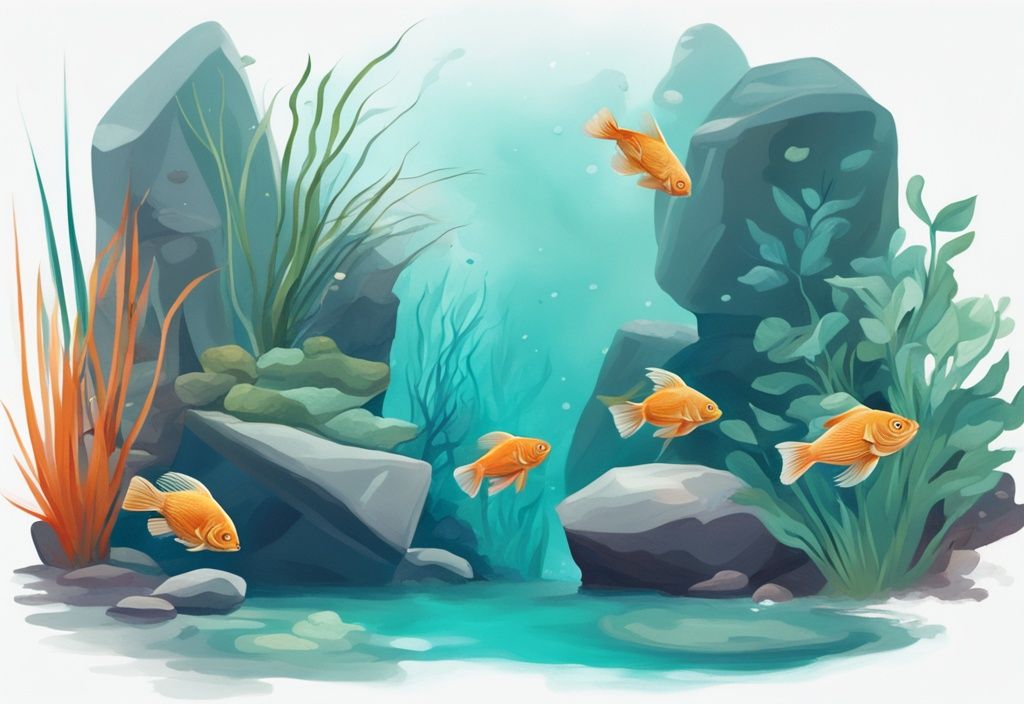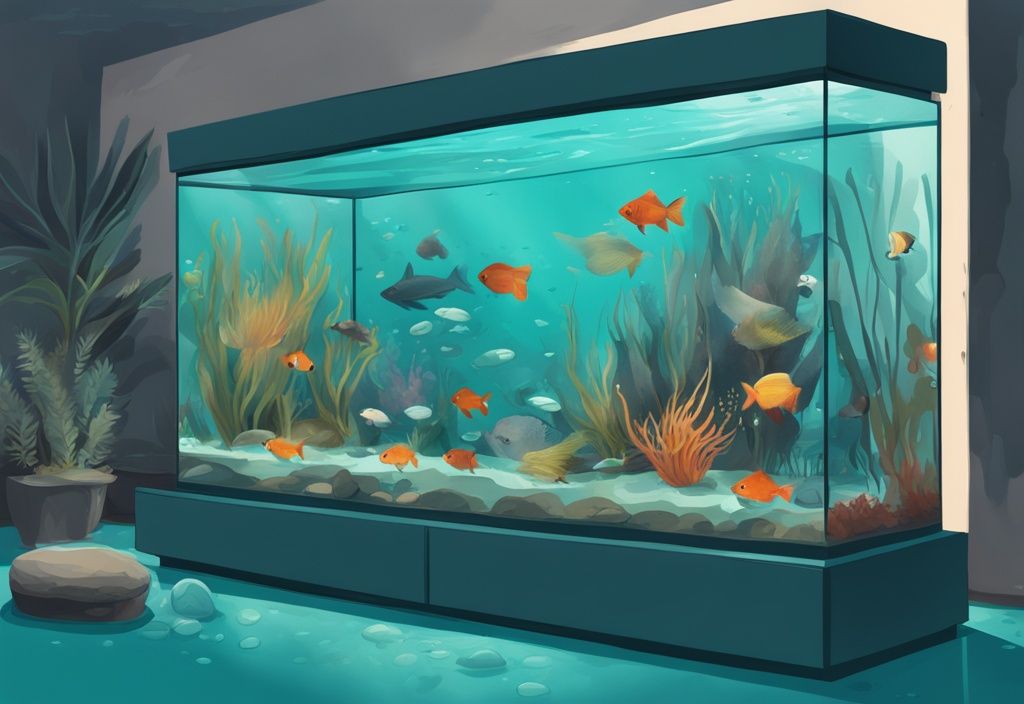Are you yearning for the tranquil beauty of an aquarium in your home, but intimidated by the perceived complexities? Set your worries aside. As your dedicated guide, I’ll be assisting you on their fishes cold water adventure, turning your apprehensions into confident strides.
Raising cold water aquarium fish can be an incredibly rewarding journey, as research suggests that spending time in aquariums could improve physical and mental wellbeing, including significant reductions in heart rates and blood pressure, making it a fulfilling hobby for both you and your aquatic friends. For more information, visit this article. These fascinating species, like the vibrant Goldfish or zestful Zebra Danio, exhibit unique splendour and vitality, thriving in cooler temperatures without the need for a heater.
This guide is designed to equip you with ample knowledge—from choosing the right species to establishing the perfect aquatic ambience for your scaly friends. Together, let’s create a thriving eco-system within your home, ensuring your cold water ecosystem bursts with life, and your passion for aquatics blossoms. Dive in!
Your Guide to Cold Water Aquarium Fish
In this guide, you will discover the fascinating world of cold water aquarium fish, what makes them unique, and why they could be the ideal choice for your home aquarium.
What Makes a Fish a Cold Water Species?
Cold water aquarium fish are a marvel of the aquatic world, thriving in temperatures that mimic typical room conditions without the need for additional heating. These remarkable creatures flourish in cooler environments, generally between 50-60 degrees Fahrenheit (10-15 degrees Celsius). This is noticeably different from tropical fish, which prefer the warmer range of 72-82 degrees Fahrenheit (22-28 degrees Celsius).
These cold water wonders are predominantly found in temperate zones across various continents. Imagine the hardy Goldfish, the energetic White Cloud Mountain Minnow, and the vibrant Zebra Danio. These species have adapted beautifully to cooler climates, showcasing nature’s incredible versatility.
Why Should You Consider Keeping Cold Water Aquarium Fish?
There are several compelling reasons to consider cold water aquarium fish for your aquatic sanctuary. Firstly, these resilient fish typically require less maintenance than their tropical cousins, making them an excellent choice for beginners. Who wouldn’t appreciate a more straightforward start to their fishkeeping journey?
Moreover, by opting for cold water species, you save on the costs associated with heaters and electricity, as these fish thrive in ambient room temperatures. The financial and environmental savings are a win-win!
Another advantage is their incredible adaptability. Cold water fish are versatile and can thrive in a wide range of environmental conditions. For example, species like goldfish and minnows are known for their robust nature and ease of care, making them perfect for someone just getting started with an aquarium. Their tenacious spirit ensures a satisfying and manageable fishkeeping experience, helping you build confidence as an aquarist.
Your Guide to the Best Cold Water Aquarium Fish
Choosing the right cold water aquarium fish can make or break your aquatic experience. The following sections will help you discover various species that thrive in cooler environments, ensuring your aquarium is both vibrant and healthy.
Goldfish: A Classic Choice
Goldfish are arguably the most iconic cold water aquarium fish, cherished for their diverse beauty and size variations. Starting small, goldfish grow significantly, often requiring larger tanks or outdoor ponds. Their popularity stems from the myriad of varieties like the elegant Fantail or the exotic Lionhead, each bringing unique charm to your aquarium.
These fish are not just ornamental but also robust, making them ideal for beginners. Their long lifespan, sometimes exceeding 10 years, ensures a lasting companionship for any aquarist.
White Cloud Mountain Minnow: The Colorful Option
White Cloud Mountain Minnows inject color and vitality into cold water setups with their playful demeanor and vibrant looks. Resilient by nature, they withstand temperatures as low as 40°F but flourish in the 51°F to 72°F range. Whether you choose traditional or the new gold-colored variants, these minnows are a visual treat. If you’re considering relocating your aquatic setup, learn how to move a fish tank to ensure a smooth transition for your finned friends.
Ideal for community tanks, their lively activity and hardiness make them perfect for both novice and seasoned aquarium enthusiasts.
Zebra Danio: Easy and Active
Zebra Danios are beginner-friendly and highly adaptable to cooler temperatures, thriving in the mid-60s°F range. Native to South Asia, these fish are celebrated for their energetic swimming and striking zebra-like patterns.
Their ease of care makes them a delightful addition for those new to maintaining cold water aquarium fish. Their interactive behavior provides endless entertainment, making your aquarium more dynamic.
Explore More with These Other Cold Water Fish Species
Beyond goldfish, minnows, and danios, a wealth of other cold water aquarium fish awaits discovery. The Sunset Variatus Platy, a hardy livebearer, thrives in higher pH levels and offers a spectrum of colors. Meanwhile, the Celestial Pearl Danio captivates with its golden spots and red-orange fins, ideal for aquascaping.
The Rainbow Shiner, native to the USA, dazzles with pink and purple hues, particularly during mating season. For those battling algae, the Hillstream Loach not only aids in cleanup but also stands out with its unique appearance, favoring temperatures in the mid to upper 60s°F range.
Breeding enthusiasts might consider the Endler’s Livebearer and the nano-sized, colorful Clown Killifish, both known for hardiness and adaptability. The Pearl Danio and peaceful schooling fish like Bloodfin Tetra and Buenos Aires Tetra thrive in cooler conditions and add harmony to your tank.
Larger species such as the Dojo Loach and Comet Goldfish are exceptional for ponds or spacious tanks, bringing fascinating behaviors to observe. For those seeking unique species, consider the Candidius Goby, Bluefin Killifish, and Glowlight Danio, each requiring specific temperature ranges but flourishing in cold water environments.

Highly adaptable options like the Japanese Ricefish and Mosquitofish offer broad temperature tolerances, making them versatile additions to various tank setups.
Each of these species contributes a distinct appeal, turning your cold water aquarium into a diverse, visually stunning aquatic habitat.
Your Cold Water Fish Aquarium: Setting It Up
Crafting the perfect environment for your cold water aquarium fish involves careful planning and thoughtful choices. Let’s dive into the key aspects of setting up an ideal habitat.
Choosing Your Cold Water Fish Tank
When starting a cold water aquarium, selecting the right tank is crucial. The size of your tank must correspond to the types and number of fish you plan to keep.
Always consider their adult size and activity level to provide a comfortable environment.
For example, cold-water species like Goldfish grow significantly larger than most other aquarium fish, necessitating spacious tanks or even outdoor ponds as they mature. Therefore, plan accordingly to avoid overcrowding and ensure the overall well-being of your cold water aquarium fish.
The Right Filtration System for Your Cold Water Aquarium
An effective filtration system is essential for maintaining a healthy habitat for your cold water aquarium fish. This system helps keep the water clean and well-oxygenated, which is vital for the fish’s health.
Different species might have specific needs, so it’s important to choose a filtration system that matches those requirements. For instance, while some fish might thrive with a standard filter, others may need more specialized setups to ensure optimal water quality and circulation.
Creating the Perfect Cold Water Aquascape
Crafting an ideal aquascape for your cold water aquarium fish involves careful selection of plants and decorations that can thrive at cooler temperatures.
Opt for robust aquatic plants that can handle the lower ranges of 50-60 degrees Fahrenheit, and make sure your decorations do not impede the movement of your active fish. Include ample hiding spots to reduce stress and mimic their natural habitats, creating a soothing and visually appealing environment.
This thoughtful approach will not only enhance the look of your aquarium but also contribute to the well-being of your fish.
Your Guide to Cold Water Aquarium Fish
Cold water aquarium fish can be a delightful addition to any home aquarium. This guide covers essential care tips, from water parameters and diet to breeding and disease prevention. Dive in for a comprehensive look at how to ensure your cold water fish not only survive but thrive in their aquatic environment.
Water Parameters: Ensuring Your Fish Thrive
Maintaining proper water parameters is crucial for the well-being of cold water aquarium fish. Regularly monitor the water temperature, ensuring it remains within the specific range suitable for your species. Cold water fish typically thrive between 50-60 degrees Fahrenheit. Additionally, keep a close check on ammonia levels, as even a small increase can stress or harm your fish.
Balanced pH levels and water hardness also play vital roles in preventing illnesses and ensuring overall health. Regular water testing kits can help maintain a stable and safe environment for your aquatic pets. Remember, consistency is key to a healthy and happy cold water aquarium.
Diet & Feeding: Keep Your Cold Water Fish Healthy
Understanding the dietary needs of your cold water aquarium fish is essential for their growth and health. These fish often benefit from a varied diet that includes frozen, live, or dried foods. Make sure to provide a balanced diet that caters to their nutritional needs.
Feed your fish small amounts once or twice daily, ensuring they consume the food within a few minutes. Overfeeding can lead to poor water quality and health problems, so it’s crucial to monitor feeding quantities carefully. Remember, a little attention to detail in their diet can go a long way.
Breeding Cold Water Fish: A Beginner’s Guide
Breeding cold water aquarium fish can be a rewarding experience, though it requires understanding some key differences compared to tropical fish breeding. Create a conducive environment by setting appropriate water parameters and providing ample hiding spots for eggs and fry.
Stable temperatures and clean water conditions are critical for successful breeding. Observing the specific breeding behaviors of your fish species can help you create the optimal conditions for raising healthy offspring. Patience and attention to detail can turn this process into a fascinating journey.
Preventing Common Fish Illnesses
Preventing common fish illnesses in your cold water aquarium involves vigilance and prompt action. Learn to identify symptoms of frequent illnesses like swim bladder disease and dropsy. Regularly monitor your fish’s health and take immediate steps if you notice any signs of distress or illness.
Maintaining stable and clean water conditions significantly reduces the risk of disease. Implementing a regular tank maintenance routine can help ensure a healthy environment for your fish. A proactive approach can make all the difference in keeping your aquatic friends healthy.

Your Ultimate Guide to Cold Water Aquarium Fish
Discover everything you need to know about setting up a thriving cold water aquarium, from selecting the right fish to maintaining a balanced environment. Dive into expert insights and practical tips to make your cold water aquarium a serene, beautiful showcase.
Best Places to Buy Cold Water Aquarium Fish: Online vs In-Person
When creating a cold water aquarium, one of the most critical steps is choosing where to buy your fish. Both online stores and local pet shops offer unique benefits and challenges that can influence your decision.
Local Pet Stores: Frequenting a reputable local pet store allows for direct observation of the fish’s health and conditions before purchase. Having a conversation with knowledgeable staff can provide you with personalized advice tailored to your specific needs. Moreover, you can inspect the store’s setup, ensuring they uphold high standards of cleanliness and care. However, the selection might be narrower compared to online platforms.
Online Retailers: Reputable online retailers often provide a more extensive range of cold water fish species, along with the convenience of home delivery. These platforms offer detailed descriptions and care guides, aiding you in making an informed decision. It’s essential to research and opt for trusted sellers known for their ethical practices and quality services. For more insights, explore our guide on beneficial bacteria for fish tanks to ensure a healthy aquatic environment. Though you can’t inspect the fish beforehand, and shipment can sometimes stress the fish, reviewing customer feedback and seller ratings can help alleviate these concerns.
Comparison: When selecting where to purchase your cold water aquarium fish, consider the convenience, variety, and fish quality. Local stores provide hands-on experiences and immediate transactions, while online retailers offer broader choices and easier access. Balancing these factors based on your personal preferences and requirements will ensure a successful and rewarding fish-keeping journey.
Understanding the Costs of Raising Cold Water Aquarium Fish
The journey of raising cold water aquarium fish is filled with both joy and responsibility. To ensure a thriving aquatic environment, it’s crucial to familiarize yourself with the related expenses. Below, you’ll find a breakdown of the initial setup costs, ongoing costs, and potential additional costs involved in maintaining a cold water aquarium.
Initial Setup Costs
The initial setup for cold water aquarium fish includes several essential components. Purchasing a quality tank is a primary expense. Selecting the right size tank is vital; consider the adult size and behavior of the fish you wish to keep.
A reliable filtration system is another crucial investment. Clean, well-oxygenated water is paramount to the health of your fish. Additionally, to create a natural and enriching environment, you’ll need to choose appropriate plants and decorations compatible with cooler temperatures.
Ongoing Costs
Maintaining a cold water aquarium fish setup involves several recurring expenses. One of the most significant is fish food, and it’s essential to provide a balanced diet suitable for your specific species.
Over time, you’ll need to replace filter media to keep your filtration system functioning effectively. While cold water fish generally don’t require heaters, other electrical equipment might slightly affect your energy bills.
Potential Additional Costs
Owning cold water aquarium fish can sometimes bring unexpected expenses. For instance, medications might be needed to treat common fish illnesses, ensuring the health and vitality of your aquatic pets. In rare cases, emergency veterinary care could be necessary, and this can incur significant costs.
Being prepared for these possibilities is essential to maintaining a healthy and stress-free environment for your fish. By anticipating these potential costs, you can ensure that your cold water aquarium becomes a serene haven for its inhabitants.
Understanding Cold Water Aquarium Fish
What Makes a Fish a Cold Water Species?
- Cold-water aquarium fish thrive at room temperature without heaters.
- These species prefer cooler temperatures, typically ranging from 50-60 degrees F (10-15 C) compared to tropical fish which require 72-82 degrees F (22-28 C).
- Usually found in temperate zones across various continents.
- Examples of cold-water fish include Goldfish, White Cloud Mountain Minnow, Zebra Danio, among others.
Why Should You Consider Keeping Cold Water Aquarium Fish?
- Cold-water fish are hardy and generally need less maintenance than tropical fish.
- No heater requirement reduces equipment costs and energy use.
- These fish can easily adapt to a variety of environments.
- Many species are ideal for beginners due to their resilience and ease of care.
Your Choices: Best Cold Water Aquarium Fish
Goldfish: A Classic Choice
- Best-known cold-water fish but can grow very large, making them suitable for larger tanks or outdoor ponds.
- Many goldfish varieties exist, each with unique characteristics and sizes.
White Cloud Mountain Minnow: The Colorful Option
- Active and playful, tolerates temperatures as low as 40°F, with an optimal range of 51°F-72°F.
- Known for their resilience, including new gold-colored variants.
Zebra Danio: Easy and Active
- Hardy fish that tolerate temperatures in the mid-60s F, making them easy to care for.
- Highly active and suitable for beginners.
- Sourced from South Asia.
Explore More with these Other Cold Water Fish Species
- Sunset Variatus Platy: Hardy, livebearers, available in various colors, prefer pH above 7.0.
- Celestial Pearl Danio: Popular nano fish with golden spots and red-orange fins, good for aquascaping.
- Rainbow Shiner: Native to the USA, vibrant purple and pink colors, especially during mating season, prefer groups.
- Hillstream Loach: Effective algae eaters, with an unusual appearance, prefer pH of 6.6 to 7.8, suitable for mid to upper 60s F temperatures.
- Endler’s Livebearer: Smaller than guppies, very hardy and adaptable, easy to breed.
- Clown Killifish: Nano fish with striking colors, prefer swimming at the top of the tank.
- Pearl Danio: Hardy, tolerates mid-60s F temperatures, native to Sumatra, Laos, and Thailand.
- Bloodfin Tetra: Tolerates mid-60s F, peaceful and best kept in schools, native to Southern Brazil and Paraguay.
- Buenos Aires Tetra: Easily found, tolerates mid-60s F, available in standard and albino variants.
- Gold Barb: Popular for cooler aquariums, should be kept in groups, requires some water flow with a slightly aggressive nature.
- Dojo Loach: Can grow up to 10-12 inches, extremely tolerant of cool temperatures, display fascinating behaviors, found in East Asia.
- Rosy Barb: Tolerates mid-60s F temperatures, from Afghanistan and Bangladesh.
- Two Spot Barb: Bright red, tolerates cooler temperatures, found in Nepal, India, and Pakistan.
- Cherry Shrimp: Known for bright colors and algae-eating habits, easy to breed.
- Chinese High-Fin Banded Shark: Not suitable for most aquariums due to large size, better for ponds.
- Comet Goldfish: Best suited for ponds, require large tanks and can withstand temperatures in the 60-75°F range.
- Candidius Goby: Prefers cool-water conditions, temperature range 57-68°F.
- Bluefin Killifish: Thrive in temperatures between 55°F-70°F, known to jump, requires a tight-fitting lid.
- Glowlight Danio: Schooling fish from Myanmar, suitable for temperatures between 61-79°F.
- Japanese Ricefish: Highly adaptable, can live in temperatures ranging from 32°F to 108°F.
- Mosquitofish: Small-sized, eat mosquito larvae, can withstand temperatures from 33°F to 104°F.

Your Cold Water Fish Aquarium: Setting It Up
Creating an optimal environment for your cold water aquarium fish requires careful consideration of tank size, filtration systems, and aquascaping. Each element plays a crucial role in ensuring a healthy and thriving ecosystem.
Choosing Your Cold Water Fish Tank
- Ensure the tank size is adequate for the types and number of cold-water fish you plan to keep, considering their adult size and activity level.
- Cold-water fish like Goldfish require larger tanks due to their potential size.
The Right Filtration System for Your Cold Water Aquarium
- A good filtration system is necessary to maintain clean water and proper oxygen levels.
- Consider the specific requirements of your chosen fish species when selecting a filtration system.
Creating the Perfect Cold Water Aquascape
- Include plants and decorations suitable for cooler temperatures.
- Ensure aquascape does not hinder fish movement and provides hiding spots.
- Emphasize creating a natural and stress-free environment for the fish.
How to Care for Your Cold Water Aquarium Fish
Water Parameters: Ensuring Your Fish Thrive
- Regularly monitor the water temperature, aiming for the specific range suitable for your fish species.
- Check and maintain appropriate ammonia levels, pH levels, and water hardness to prevent stress and illness.
Diet & Feeding: Keep your Cold Water Fish Healthy
- Understand the dietary needs of your cold water fish, including the types of food (frozen, live, or dried) that are best for them.
- Feed your fish a balanced diet to ensure proper growth and health.
Breeding Cold Water Fish: A Beginner’s Guide
- Learn the differences between breeding cold water fish and tropical fish.
- Set up a conducive environment for breeding, which may include specific water parameters and hiding spots for eggs and fry.
- Ensure stable temperature to promote breeding and healthy offspring.
Preventing Common Fish Illnesses
- Identify symptoms of common illnesses such as swim bladder disease and dropsy.
- Regularly monitor fish health and promptly take action at the first sign of illness.
- Maintain stable water conditions to reduce the risk of disease.
Finding Your Cold Water Aquarium Fish
When sourcing cold water aquarium fish, it’s essential to consider the health, variety, and quality of the fish from your chosen suppliers. Explore both online and in-person options to find the best sources.
Best Places to Buy Cold Water Fish: Online vs In-Person
- Consider reputable local pet stores for in-person purchases to see the fish’s health and conditions.
- Research trusted online retailers who offer a wide range of cold-water fish species with delivery services.
- Evaluate the pros and cons of each purchasing method based on convenience, variety, and quality of fish.
Understand the Costs of Raising Cold Water Aquarium Fish
- Initial setup costs: tank, filtration system, plants, and decorations.
- Ongoing costs: fish food, replacement filter media, and electricity for equipment.
- Potential additional costs: medications and emergency veterinary care.
Answering Your Cold Water Aquarium Fish Questions
Best Cold Water Fish for Beginners: Making Your Choice
When starting with cold water aquarium fish, opt for species known for their hardy nature and ease of care. Goldfish, Zebra Danio, and White Cloud Mountain Minnow are excellent choices for beginners. These fish are resilient and can thrive in a variety of water conditions, making them forgiving to common beginner mistakes. If you’re struggling with pest control, you might want to learn how to manage snails in your aquarium. Additionally, Endler’s Livebearer and Sunset Variatus Platy are also suitable for newcomers. Their adaptability and low maintenance requirements make them straightforward options for those new to cold-water fish keeping.
Do Cold Water Fish Need a Heater: Yes or No?
No, cold water fish do not need a heater. They are adapted to thrive at room temperature or cooler environments that align with their natural habitat. Such fish are comfortable with temperatures ranging between 50-60 degrees Fahrenheit. Steady and natural temperature fluctuations within this range are generally acceptable, providing the species-specific needs are respected.
How Often Should Cold Water Fish Be Fed?
Cold water fish should be fed once or twice daily. Provide small amounts of food that they can consume within a few minutes to avoid overfeeding. Overfeeding can lead to water quality issues and potential health problems for your fish. A consistent feeding schedule supports the fish’s overall health and helps maintain a balanced ecosystem in your aquarium.
